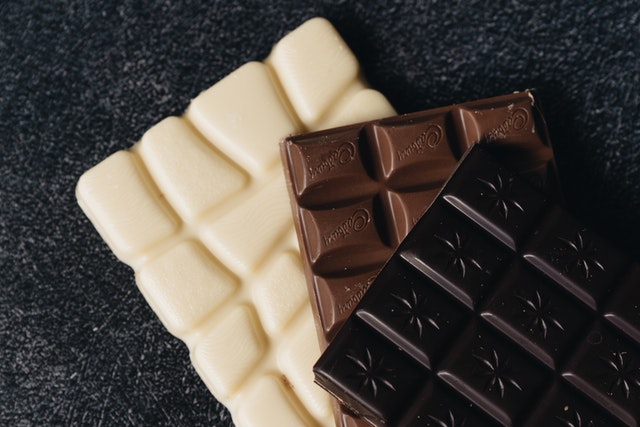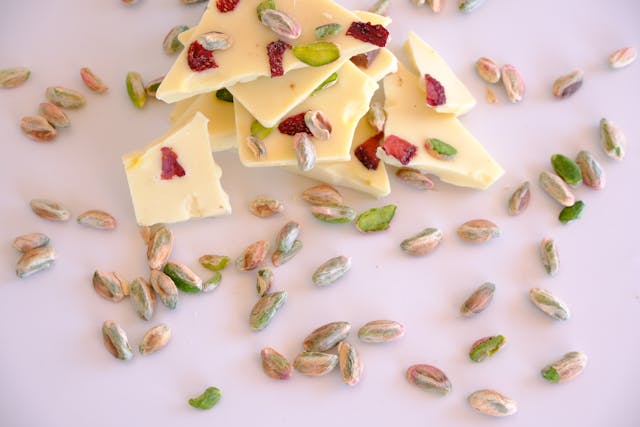
Pets and Chocolate: Vets Say White Chocolate is Unlikely to Poison
June 1, 2024
Dairy vs. Popular Plant Milks – Almond, Oat, Coconut, and Soy Milks
July 21, 2024White Chocolate
A Comprehensive Guide
There are about 13 types of chocolate divided between eating chocolate (bars) and confectionery chocolate for baking, coating, and other creative uses. Among these, the traditional types are dark chocolate, milk chocolate, and white chocolate. Each traditional type of chocolate differs from the others by ingredient composition, and, in the case of white chocolate, the absence of the non-fat component of the cacao bean.
This article focuses on white chocolate: what it is, its uniqueness from other types of chocolate, its benefits, as well as its drawbacks.
What is white chocolate and why it’s called ‘white’?
Before we define white chocolate, it’s necessary to get the basics of where chocolate comes, for a better understanding of the colour difference in types of chocolate.
The raw material for chocolate is the cacao bean, the seed of the cacao tree. This cacao bean contains almost the same amount of fat and solids, which can be separated if necessary.
Usually, when making chocolate from bean to bar, cacao fat is not separated from cacao solids since the entire bean is used. But they’re sometimes separated, for example, if you want cacao fat (cacao butter) and cacao powder as separate products. Here’s how to extract cacao fat from the bean:
· Roast cacao beans
· Remove shells to get nibs
· Grind nibs into a mass
· Press mass to extract cacao fat
Cacao fat, also called cacao butter, is pale yellow or ivory and solidifies at room temperature.
What remains after you extract the cacao fat is a dark brown cake, which is then ground to make cacao powder or cocoa powder. The dark brown, non-fat part of cacao is what is called cacao solids. Cacao solids give normal chocolate its dark colour (for dark chocolate) or brown colour (for milk chocolate). White chocolate lacks these brown cacao solids.
Until 1936, all chocolate had both cacao solids and cacao fats, though in different percentages, plus other ingredients according to the chocolate maker’s formula. Then Nestle introduced the first modern white chocolate in 1936 by removing the brown cacao solids from the traditional formula. That was 61 years after Daniel Peter, a Swiss chocolatier, developed the recipe for milk chocolate, a base recipe for white chocolate.
In simple terms, white chocolate is chocolate that does not contain brown cocoa solids, the part of the cacao bean that gives chocolate its characteristic dark or brown colour.
However, for marketing purposes, different countries have regulations for what might be labelled white chocolate in their markets.
In the European Union, including the United Kingdom, as well as the US and Canada, white chocolate must contain at least 20% cacao fat, at least 3.5% milk fat, at least 14% of milk solids. US regulation gives room for a maximum of 55% of optional nutritive carbohydrate sweetener. Type of milk solids vary by country. It could be butter, skim milk, concentrated milk, dried milk or malted milk.
The basic ingredients for white chocolate are cocoa butter, milk fat, milk solid, and sugar. But there are varieties of white chocolate in the market as chocolate makers differentiate to bring unique products to their consumers. For example, we have a vegan version of toasted white chocolate with coconut milk in place of dairy.
Caption: Nostradamus 35% is a caramelly dairy-free blonde chocolate bar with hibiscus and cocoa nibs for a crunchy treat. Other ingredients include coconut sugar blossom and sea salt. It contains 35% by weight of cacao butter. Vegan-friendly snack, tastier and less sweet than the typical plain white chocolate.
Called White But Not White
White chocolate is not actually white, unless it’s been bleached (you need to avoid such chocolate). Natural white chocolate is ivory or pale yellow. When natural white chocolate is toasted, you get blonde chocolate which has a golden colour.
Nutrition facts for 100g of white chocolate
Calories and nutrients: A standard plain white chocolate bar has 539 calories, divided as 32g of fats, 6g of protein, and 59g of net carbohydrates. (source)
Minerals & vitamins: White chocolate has decent amounts of calcium, potassium, phosphorus, smaller amounts of magnesium, B vitamins (b1, b2, b3, b5, b6, b9, and b12), and trace amounts of vitamin C and other minerals.
100g of white chocolate, standard bar, gives:
· Calcium 100mg
· Potassium 286mg
· Magnesium 12mg
· Phosphorus 176mg
Calories, nutrients, and minerals are not the same in each bar of white chocolate. Each product differs in terms of ingredient compositions and what the maker adds to their formula.
Vegan White Chocolate
The difference between white chocolate and milk chocolate is cacao solids. So standard white chocolate is not vegan-friendly. Fortunately, vegan white chocolate exists with full vegan-friendly brands like Bantu Chocolate or other brands that cater to a subsection of their vegan customers.
The ingredients in dairy-free white chocolate are cocoa butter, plant-based milks, and sugar for sweetener, but variety exists in terms of other inclusions. For example, our toasted white chocolate has hibiscus, which has been linked to several health benefits because of its many antioxidants.
Depending, vegan white chocolate can be healthy or unhealthy. Vegan white chocolate high in added sugars is not healthy.
The Uniqueness of White Chocolate
When you hear or read ‘chocolate’, what does your mind’s eye see? Likely a brown solid crunchy bar, or brown sheeny delicious spread on toast. Whatever form you imagine is likely brown in colour.
The uniqueness of white chocolate is that it stands on a lane of its own. Without cocoa solids, it lacks some of the nutrients found in brown or dark chocolate. That can be an advantage or downside depending on the preferences of the individual consumer. More on that below.
“But white chocolate isn’t even real chocolate!”
Reddit forums have these fights over the legitimacy of white chocolate to be called chocolate at all. White chocolate does not have cocoa solids, but legally, it is labelled chocolate with regulations around how much basic ingredients a product can have.
But white chocolate does have cacao, though just the fatty portion. The thing about cocoa butter is that it defines the physical properties of chocolate. That shiny look and creamy smoothness that melts on the tongue is thanks to cocoa butter, which all real chocolate should have. So, technically, if chocolate is about cacao, and not just cacao solids, white chocolate is chocolate, only physically and nutritionally different from its brown siblings.
However! there’s white ‘chocolate’ out there that’s not really chocolate because it contains no cocoa butter. That is, fake white chocolate. The products may still have fake chocolatey flavours and producers may opt for creative names that don’t violate regulations, but consumers have to dig into product details to know it’s not white chocolate they’re eating or drinking.
How White Chocolate is Made
White chocolate is made from cocoa butter, sugar, and milk solids. This makes its process different from the general chocolate-making process.
1. Cocoa Butter Extraction: Cocoa beans are roasted and crushed to extract cocoa butter.
2. Mixing Ingredients: Cocoa butter is combined with sugar, milk solids, and other flavourings such as vanilla and emulsifiers like lecithin.
3. Heating and Melting: The mixture is heated and melted together to form a smooth liquid.
4. Cooling and Forming: The liquid mixture is then cooled and allowed to solidify into bars, chips, or other forms.
Health Benefits of White Chocolate
Without cacao solids, is white chocolate healthy?
Just because it does not have cacao solids does not make white chocolate unhealthy. White chocolate is a good source of dietary fats, proteins, and carbohydrates, along with minerals and vitamins.
Cacao butter, the main ingredient in real white chocolate, is a source of some good minerals like potassium, magnesium, phosphorus, zinc, iron, and copper. Milk, a stable in white chocolate, also has minerals like potassium, magnesium, and calcium. White chocolate also has many B vitamins.
According to Healthline, these minerals provide the following benefits to the body:
- Potassium helps lower blood pressure
- Phosphorus supports bone health
- Copper supports brain health
- Iron supports red blood cell activity
- Zinc supports immune health
- Magnesium supports muscle and nerve health
- Calcium supports bone health
Cacao butter also has polyphenols, though not as much as in dark or milk chocolates because cacao solids take the lion’s share of the cacao bean polyphenols. Polyphenols are antioxidants that help the body fight the negative effects of oxidative stress. They have benefits for heart health.
A healthy way to consume white chocolate is to watch out for the amount of added sugar proportional to other macronutrients.
Nostradamus 35% dairy-free chocolate is a good choice if you’re looking for a not-too-sweet (read low in sugar) tasty white chocolate with only 27g of sugar in 100g. That is, 18.97g in a bar which you can down in one sitting.
White Chocolate Vs. Dark Chocolate
It’s not just about the colour. There are big differences between white and dark chocolate. White chocolate does not have cacao solids, while dark chocolate does not have milk. Because of cacao solids, dark chocolate is more nutritious than white chocolate. Dark chocolate also contains a higher amount of polyphenols which are responsible for many health benefits of cacao and chocolate.
Compared in caloric content,
|
|
Calories in 100g |
Fats |
Proteins |
Carbs |
Sugar |
|
Plain white chocolate |
539 |
32g |
6g |
59g |
58.8g |
|
Plain dark chocolate |
546 |
31g |
4.9g |
|
54g |
Individual product info differs. Always check product labels.
Dark chocolate is rich in caffeine and theobromine, which white chocolate does not have.
Which is better between dark chocolate and white chocolate? Well, if you enjoy chocolate for that bittersweet taste or for health benefits of cacao solids, dark chocolate is your go to. If you can’t stomach cacao solids, white chocolate is your best substitute.
White Chocolate vs. Milk Chocolate (Brown Chocolate)
White chocolate is milk chocolate without cocoa solids. This makes white chocolate lack some of the compounds found in milk chocolate. Which one is better? It depends on individual preferences and health reasons. Consumers with cacao intolerance or allergies would find white chocolate a better choice. There are vegan-friendly substitutes for both white chocolate and milk chocolate for people with lactose intolerance.
In terms of calories and macronutrients,
|
|
Calories in 100g |
Fats |
Proteins |
Carbs |
Sugar |
|
Plain white chocolate |
539 |
32g |
6g |
59g |
58.8g |
|
Plain milk chocolate |
535 |
30g |
8g |
|
55.6g |
|
Nostradamus 35% toasted white chocolate |
615 |
48.6g |
1.67g |
38.8g |
27.1g |
|
Limbe 55% milk chocolate |
689 |
37.1g |
5.9g |
42.8g |
34.6g |
Always check individual product details for accurate nutrition information. For example, here’s how our white and milk chocolates compare against each other.
|
|
Calories in 100g |
Fats |
Proteins |
Carbs |
Sugar |
|
Nostradamus 35% toasted white chocolate |
615 |
48.6g |
1.67g |
38.8g |
27.1g |
|
Limbe 55% milk chocolate |
689 |
37.1g |
5.9g |
42.8g |
34.6g |
LEARN MORE: Calories in Different Types of Chocolate
White Chocolate vs. Blonde Chocolate
There’s a type of white chocolate that is not ‘white’ (even though white chocolate is ivory or pale yellow!). Blonde chocolate is white chocolate that has been slowly heated to invoke the Maillard’s reactions in order to change the colour from pale ivory to golden. That’s the same reaction that gives a golden-brown to bread crust, buns, baked goods, grilled meats, and fries.
Nutritionally, white chocolate and blonde chocolate are the same. But flavours are not.
Nostradamus 35% toasted white chocolate is actually blonde chocolate. It has a caramel-flavour while plain white chocolate tends to have a buttery, milky taste.
Why would anyone want white chocolate or blonde chocolate?
White chocolate makes up about 10% (2022 stat) of the global market size for chocolate and several market research groups forecast continuous growth.
But the question remains: why would anyone want white chocolate when they can have milk or dark chocolate with their full cocoa bean goodness?
It comes down to individual preferences. While some consumers can’t stand white chocolate, others vow to die on the hill of white chocolate’s superiority to those with cocoa solids.
These are some reasons some consumers love white chocolate:
· Sweeter and tastier: This could be because the sugar component ‘shines’ forth better in cocoa butter without the bitterness of cacao solids. It’s mostly for those with a sweet tooth who want something sweeter than milk or dark chocolate.
· Cocoa solid intolerance or allergies: For people whose systems cannot tolerate cocoa solids, white chocolate is a great way to still enjoy this treat.
· Doesn’t stain clothing: for parents with children who love chocolate.
· Versatile: though this goes for other chocolates too, some consumers enjoy white chocolate on desserts, cookies, ice cream, on fruits, and as white hot chocolate.
The Downsides to White Chocolate
White chocolate does not contain as many nutrients, minerals and vitamins as milk chocolate or dark chocolate. Cocoa butter contains fewer polyphenols, just about 5%, compared to about 72–87% found in cocoa solids.
White chocolate also tends to be high in added sugars unlike dark chocolate with higher percentages of total cacao and lower sugar content.
How To Eat White Chocolate
You can eat white chocolate bars as they are, but that’s not all. Why not try melting white chocolate in a cup of hot water for creamy delicious white hot chocolate. White chocolate is also great as sandwich in cookies, toppings in ice creams, dipping for fruits, etc.
Learn to Identify White Chocolate Worth its Name
There are fake white chocolates out there without cocoa butter at all or barely having enough ingredients to appear like white chocolate. In the US, UK (European Union), and Canada, white chocolate must have a minimum 20% cacao fat, 3.5% milkfat, 14% of milk solids. The US regulation puts carbohydrate sweetener at a maximum of 55%.
Some manufacturers may have products without dairy to cater to vegan and lactose intolerant consumers.
A good starting place to find worthy white chocolate is to ensure the product has at least 20% by weight of cocoa butter. As cocoa butter is the only cocoa ingredient in white chocolate, any product that replaces cocoa butter with another oil is fake white chocolate.
The right way to store your white chocolate bars
Direct sunlight, very low temperatures, and moisture are not friends with chocolate bars. One would melt your bar while the others would cause chocolate bloom (say goodbye to appetizing appearance and smooth mouthfeel). Therefore, the best place to store your chocolate bar is a cool, dark spot, most preferably in the pantry. Avoid the refrigerator or freezer for moisture’s sake and because chocolate easily picks up the flavour from other foods.
If well kept, chocolate can last for months to years. But which one of us mortals has that self-control to keep a yummy bar for so long in their pantry?
Have you tasted toasted white (blonde) chocolate with hibiscus and cocoa nibs?
I bet you have never. Our dairy-free single-origin blonde chocolate, made with coconut milk, is an opportunity for you to enjoy a balance of sweet and savoury. Not-too-sweet, crunchy, caramelly, and nutritious.
Some Questions About White Chocolate
Is There Cacao in White Chocolate?
White chocolate has cacao in the form of cocoa butter, but lacks cocoa solids, the brown non-fat component of the cacao bean. This is why it is ‘white’, although the real colour is paly ivory or pale yellow.
You still may find white chocolate products with cacao solids, like our toasted white bar that has cacao nibs for crunchiness.
Is White Chocolate Vegan?
No, standard white chocolate by regulation is not vegan-friendly as it contains milk. However, there are vegan alternatives (non-legal label) like Nostradamus 35% made with coconut milk. Other chocolate makers may use other dairy alternatives like rice flour, green banana flour, oatmeal flour, and more.
References
https://www.ecfr.gov/current/title-21/chapter-I/subchapter-B/part-163#163.124
https://www.healthline.com/nutrition/cocoa-butter
https://fdc.nal.usda.gov/fdc-app.html#/food-details/167571/nutrients
https://www.healthline.com/nutrition/milk#benefits
https://damecacao.com/white-chocolate-real/
https://en.wikipedia.org/wiki/White_chocolate
https://www.healthline.com/nutrition/polyphenols
https://cocoasupply.com/blog/ingredients-to-substitute-milk-in-vegan-chocolate/
https://askinosie.com/blogs/the-nib/tips-for-storing-chocolate
Chocolate Extinction: Fact vs. Fiction + What Chocolate Lovers Can Do
Chocolate ExtinctionFact vs. Fiction, What Consumers Can Do Share On Facebook Twitter Email Is the world really running out of chocolate? Not really. Currently the global […]
Corporate Chocolate Gifting Ideas to Appreciate Employees and Delight Clients
Corporate Chocolate GiftingHow to Appreciate Employees & Delight Clients Share On Facebook Twitter Email When it comes to corporate gifting, a one-gift-fits-all approach just doesn't cut […]
Cacao Supper Club at Home: Guide to Tasting Chocolate, Cacao Tea, and Pulp Juice
Cacao Supper Club at HomeGuide to Tasting Chocolate, Cacao Tea, and Pulp Juice Share On Facebook Twitter Email Imagine gathering around the table with a few […]










